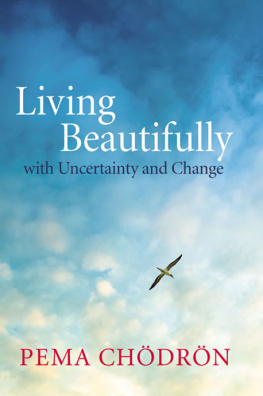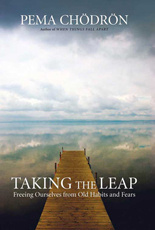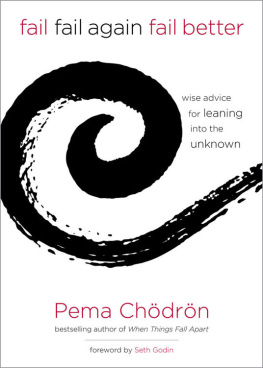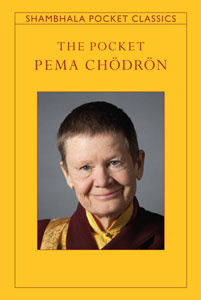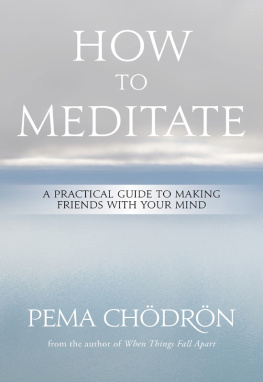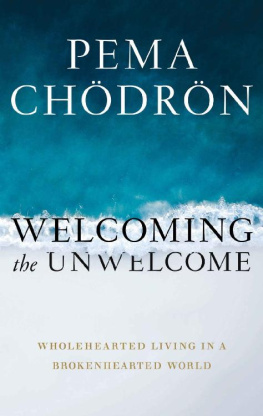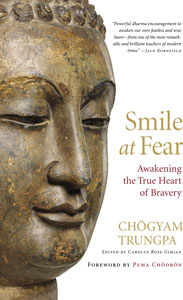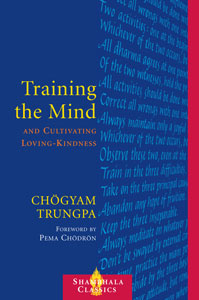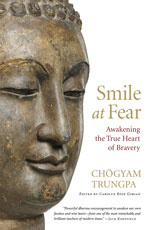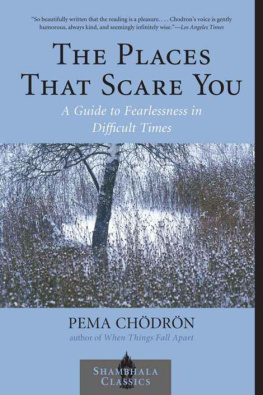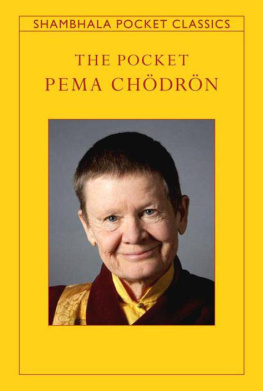ABOUT THE BOOK
We live in difficult times. Life sometimes seems like a roiling and turbulent river threatening to drown us and destroy the world. Why, then, shouldnt we cling to the certainty of the shoreto our familiar patterns and habits? Because, Pema Chdrn teaches, that kind of fear-based clinging keeps us from the infinitely more satisfying experience of being fully alive. The teachings she presents hereknown as the Three Commitmentsprovide a wealth of wisdom for learning to step right into the river: to be completely, fearlessly present even in the hardest times, the most difficult situations. When we learn to let go of our protective patterns and do that, we begin to see not only how much better it feels to live that way, but, as a wonderful side effect, we find that we begin to naturally and effectively reach out to others in care and support.
PEMA CHDRN is an American Buddhist nun in the lineage of Chgyam Trungpa. She is resident teacher at Gampo Abbey in Nova Scotia, the first Tibetan monastery in North America established for Westerners. She is the author of many books and audiobooks, including the best-selling When Things Fall Apart and Don't Bite the Hook.
Sign up to receive inspirational quotes from Pema Chdrn and special offers from Shambhala Publications.

Or visit us online to sign up at shambhala.com/eheartadvice.
LIVING BEAUTIFULLY
WITH UNCERTAINTY AND CHANGE
Pema Chdrn
Edited by Joan Duncan Oliver

SHAMBHALA
Boston & London 2012
SHAMBHALA PUBLICATIONS, INC.
Horticultural Hall
300 Massachusetts Avenue
Boston, Massachusetts 02115
www.shambhala.com
2012 by Pema Chdrn
Cover photograph by Andrew Smith
Author photograph by Liza Matthews
Excerpt from the poem Dream Corridor (page 37) is from Fuck You, Cancer & Other Poems by Rick Fields (Berkeley, CA: Crooked Cloud Project, 1997). Used by permission of Zaentz Media Center. The prayer on page 135 is used with permission of Dzigar Kongtrl. Excerpts from the translation of The Way of the Bodhisattva (Bodhicharyavatara) 1997 by the Padmakara Translation Group are reprinted with permission. Excerpts from The Words of My Perfect Teacher 1994, 1998 by the Padmakara Translation Group are reprinted with permission.
All rights reserved. No part of this book may be reproduced in any form or by any means, electronic or mechanical, including photocopying, recording, or by any information storage and retrieval system, without permission in writing from the publisher.
Library of Congress Cataloging-in-Publication Data
Chdrn, Pema.
Living beautifully with uncertainty and change / Pema Chdrn; edited by Joan Duncan Oliver.First Edition.
pages cm
eISBN 978-0-8348-2813-1
ISBN 978-1-59030-963-6 (hardback)
1. Religious lifeBuddhism. 2. UncertaintyReligious aspectsBuddhism. 3. BuddhismDoctrines. I. Oliver, Joan Duncan, editor. II. Title.
BQ5405.C45 2012
294.3444dc23
2012005546
May the aspirations of
Chgyam Trungpa Rinpoche
The Druk Sakyong
The Dorje Dradl of Mukpo
be rapidly fulfilled
Contents
THE TEACHINGS IN THIS BOOK were given at Gampo Abbey, a Tibetan Buddhist monastery in Cape Breton, Nova Scotia, in 2009, during the six-week winter retreat known as Yarne. They are loosely based on traditional Buddhist material pertaining to what are called the Three Vows: the Pratimoksha Vow, the Bodhisattva Vow, and the Samaya Vow.
Generally when this material is presented, it is with the understanding that these vows would be taken formally with a teacher. The Pratimoksha Vow would come first, followed later by the Bodhisattva Vow. And finally, if the student decided to work closely with a Vajrayana master, he or she would take the Samaya Vow.
Here, I have chosen to teach these vows in a more general way, presenting them as three commitments that anyone of any religionor no religioncan make as a way of relating to the impermanent, ever-shifting nature of our life experience, as a way of using our everyday experience to wake up, perk up, lighten up, and be more loving and conscious of other beings.
May this admittedly unconventional approach to a traditional subject be helpful and encouraging to all who read this book. And may some readers even become curious about the traditional way of taking these vows as part of the Buddhist journey to enlightenment.
PEMA CHDRN
Living is a form of not being sure, not knowing what next or how. The moment you know how, you begin to die a little. The artist never entirely knows. We guess. We may be wrong, but we take leap after leap in the dark.
AGNES DE MILLE
Life is like stepping into a boat that is about to sail out to sea and sink.
SHUNRYU SUZUKI ROSHI
A S HUMAN BEINGS we share a tendency to scramble for certainty whenever we realize that everything around us is in flux. In difficult times the stress of trying to find solid groundsomething predictable and safe to stand onseems to intensify. But in truth, the very nature of our existence is forever in flux. Everything keeps changing, whether were aware of it or not.
What a predicament! We seem doomed to suffer simply because we have a deep-seated fear of how things really are. Our attempts to find lasting pleasure, lasting security, are at odds with the fact that were part of a dynamic system in which everything and everyone is in process.
So this is where we find ourselves: right in the middle of a dilemma. And it leaves us with some provocative questions: How can we live wholeheartedly in the face of impermanence, knowing that one day were going to die? What is it like to realize we can never completely and finally get it all together? Is it possible to increase our tolerance for instability and change? How can we make friends with unpredictability and uncertaintyand embrace them as vehicles to transform our lives?
The Buddha called impermanence one of the three distinguishing marks of our existence, an incontrovertible fact of life. But its something we seem to resist pretty strongly. We think that if only we did this or didnt do that, somehow we could achieve a secure, dependable, controllable life. How disappointed we are when things dont work out quite the way we planned.
Not long ago, I read an interview with the war correspondent Chris Hedges in which he used a phrase that seemed like a perfect description of our situation: the moral ambiguity of human existence. This refers, I think, to an essential choice that confronts us all: whether to cling to the false security of our fixed ideas and tribal views, even though they bring us only momentary satisfaction, or to overcome our fear and make the leap to living an authentic life. That phrase, the moral ambiguity of human existence, resonated strongly with me because its what Ive been exploring for years: How can we relax and have a genuine, passionate relationship with the fundamental uncertainty, the groundlessness of being human?
My first teacher, Chgyam Trungpa, used to talk about the fundamental anxiety of being human. This anxiety or queasiness in the face of impermanence isnt something that afflicts just a few of us; its an all-pervasive state that human beings share. But rather than being disheartened by the ambiguity, the uncertainty of life, what if we accepted it and relaxed into it? What if we said, Yes, this is the way it is; this is what it means to be human, and decided to sit down and enjoy the ride?
Happily, the Buddha gave many instructions on how to do just this. Among these instructions are what are known in the Tibetan Buddhist tradition as the Three Vows, or Three Commitments. These are three methods for embracing the chaotic, unstable, dynamic, challenging nature of our situation as a path to awakening. The first of the commitments, traditionally called the Pratimoksha Vow, is the foundation for personal liberation. This is a commitment to doing our best to not cause harm with our actions or words or thoughts, a commitment to being good to each other. It provides a structure within which we learn to work with our thoughts and emotions and to refrain from speaking or acting out of confusion. The next step toward being comfortable with groundlessness is a commitment to helping others. Traditionally called the Bodhisattva Vow, it is a commitment to dedicate our lives to keeping our hearts and minds open and to nurturing our compassion with the longing to ease the suffering of the world. The last of the Three Commitments, traditionally known as the Samaya Vow, is a resolve to embrace the world just as it is, without bias. It is a commitment to see everything we encounter, good and bad, pleasant and painful, as a manifestation of awakened energy. It is a commitment to see anything and everything as a means by which we can awaken further.
Next page
